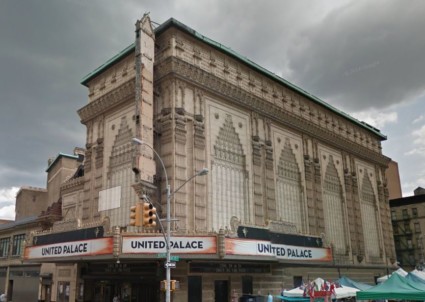Loew’s 175th Street Theater, Manhattan
Address: 4140 Broadway
Architect: Thomas W. Lamb
Constructed: 1930
LPC Action: Public Hearing 2/3/1970
LPC Backlog Hearing: Prioritized for designation
Designated December 13, 2016
The Loew’s 175th Street Theater was built as one of the Loew’s Wonder Theatres, five extravagant flagship movie palaces constructed in 1929-30 in the vicinity of New York City. The theater is a veritable palace, its exterior a flamboyant display built during a time of extreme austerity, undoubtedly meant to uplift Depression-era audiences. When it opened in 1930, the massive, freestanding theater had seats for roughly 3,600. Its architectural style is difficult to pinpoint due to its extravagant terra-cotta ornament featuring iconography from an array of cultures. The same treatment is found on the interior, itself another masterpiece. After Loew’s closed in 1969, the United Christian Evangelistic Association purchased the theater for use as a worship space, restoring the building and renaming it the Palace Cathedral. In 2007, it also began functioning as a performance space and cultural center: the United Palace, as it is widely known today.
LPC Statement of Significance
Loew's 175th Street Theatre, now the meeting house of the United Christian Evangelistic Association, Inc., is one of the finest and most exhuberant examples of the movie palaces and was built in 1932. It was one of three extravagantly ornate movie houses designed for the Loew chain by the noted theatre architect Thomas W. Lamb. No expense was spared to provide the audience with the most glamorous setting possible for the enjoyment of motion pictures.
The huge theatre, accommodating 2,726 persons, is a massive free-standing structure which occupies an entire city block. This gave the architect an exceptional opportunity and four facades, which can be seen from Broadway, 175th Street, Wadsworth Avenue and 176th Street, giving it a monumentality unusual in the city. For the design of this imposing building, constructed of brick with terra cotta trim and ornament, the architect turned to Oriental prototypes. The profusion of surface ornament, so typical of the architecture of India, makes a lively contrast to the brick surfaces. The pergola, surmounted by a dome, which rises above one corner of the building, cleverly camouflages a water tower.

